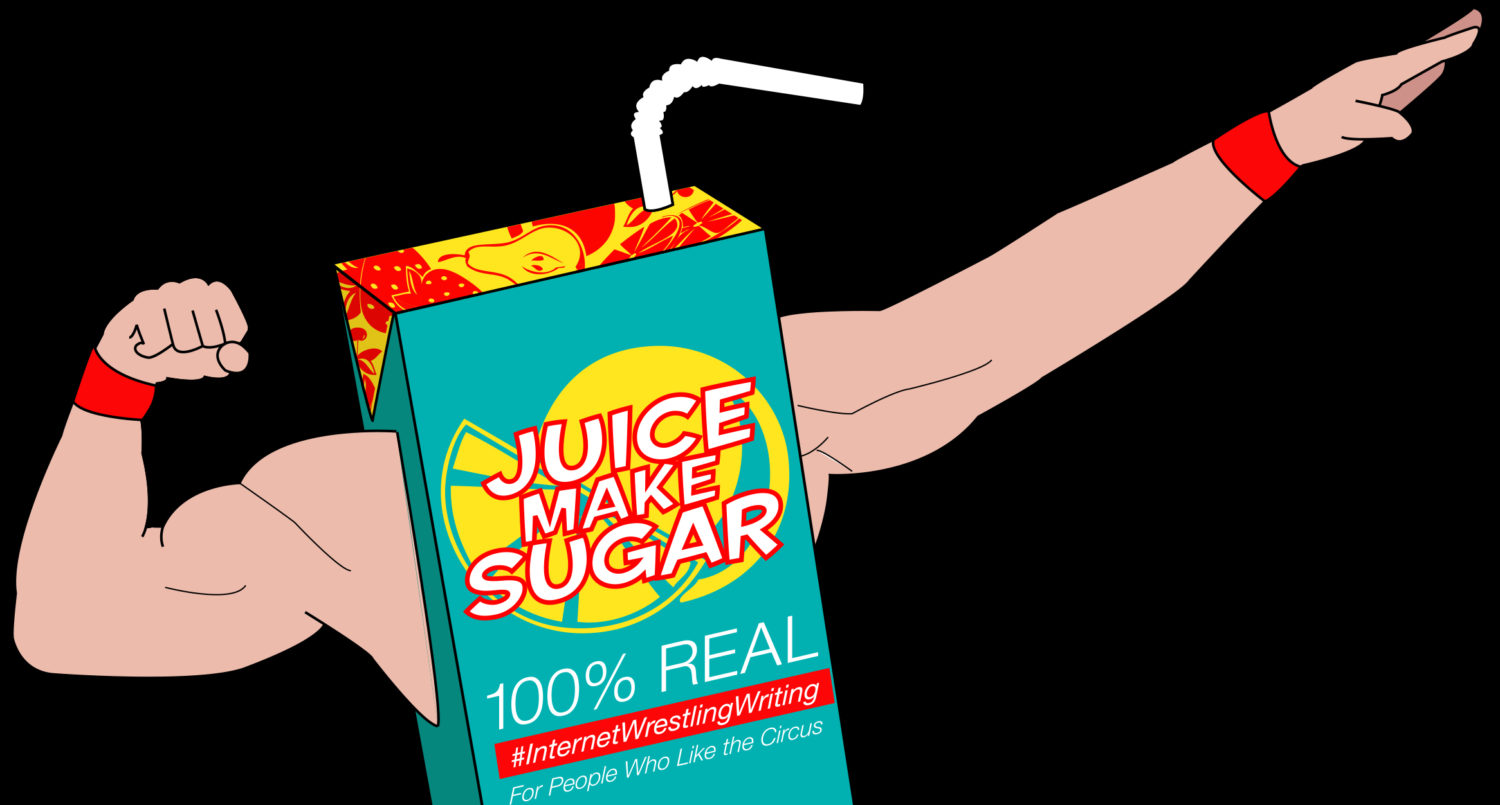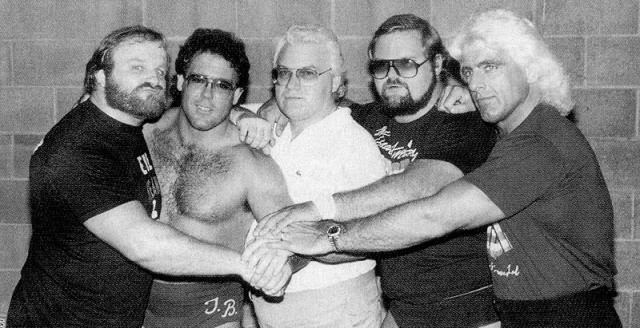It’s the First Day of #4HorsemenWeek. In celebration of this month’s Survivor Series, we’re taking a look at famous stables from the wonderful world of wrestling. This is the thirteenth installment in our (patent-pending) Juice Make Sugar Wrestler of the Week series. As always we’ll start by making The Horsemen a Stable You (Should) Probably Know Better, then give you the finer points of their oeuvre tomorrow with some Essential Viewing, and on Wednesday, we’ll be asking you to Watch and Learn. After Hump Day, we get our Buzzfeed on with a Top 10 List before finishing everything off on Friday with a Difference of Opinion (or, more likely, a celebration of the Horsemen’s specific brand of awesome.)
Any discussion of factions or stables in professional wrestling takes place in the long, dark shadow of The Four Horsemen. The Horsemen were such a successful, over act that they achieved the ultimate goal of professional wrestling: they convinced fans all around the world that they were “the best competitors” in a sport of cooperative fights and predetermined outcomes. To this day, no faction can form without the question “How do they compare to The Four Horsemen?” coming up, and the answer is always the same: “They’re no Four Horsemen.”
So, why is it that The Four Horsemen became the all-time great collection of wrestlers? Was it the charisma of Ric Flair, one of the two definitive stars of the 1980s? Yes, partly. Was it the standard-setting in-ring work ethic of all the group’s members? Yes, partly. Was it the massive talent pool of strong supporting characters in the mid-to-late 80s NWA? Yes, partly that too.
Like all great moments and movements throughout history, The Four Horsemen were a perfect storm of causes, characters, and culture. As such, nailing down the reasons for their greatness as the definitive stable is difficult, but consider the following five-point-plan to explain what made The Horsemen so special:
1. The Horsemen were an organically-created group
The Four Horsemen didn’t suddenly appear on NWA TV wearing matching trunks and proclaiming themselves the measuring stick of professional wrestling. Rather, they came together naturally over time. The Minnesota Wrecking Crew (in its third incarnation) of Arn and Ole Anderson were fake cousins, and Ric Flair was their fake second cousin. They worked together in trio feuds against the likes of Dusty Rhodes and The Road Warriors, but they were hardly a stable. The Crew were decidedly a tag team, and Ric Flair was a top champion who didn’t need anybody’s help to defend the title. However, as they worked more and more together, it became apparent to anybody who was watching that the future Horsemen had uncanny chemistry. It was never planned ahead of time, but the group was just so good that they couldn’t break them up when the trio angle was over.
To understand the value of the way The Horsemen came together naturally, consider the following counter-example: every faction in the history of TNA. All TNA’s stables from S.E.X. to The Frontline to Aces & Eights have failed because each was created artificially for a specific angle. The groups came together because a writer had a story to tell and needed a group of rude young guys or homegrown heroes or scumbag bikers to tell it. The Four Horsemen, on the other hand, lasted and thrived because they were a group that existed and became involved in angles, not a group that existed for them.
2. The Horsemen were consummate champions
If there’s any objective way to measure success in the crazy world of professional wrestling, it has to be title reigns. The various members of The Four Horsemen had over 30 different championship reigns with various titles, counting only their time in the group. Ric Flair was the default World Champion for the NWA/WCW throughout the Horsemen years, Arn Anderson was the default Television Champion from ’86 – ’91, and Horsemen teams held Tag Team Titles on five separate occasions.
With that said, there’s more to being a champion than being booked to win a title and hold it. Real, historic champions defend their titles in memorable matches against a variety of opponents, cut promos that enhance the story of their reign, and carry themselves in a way that shows fans and other wrestlers alike that they are the cream of the crop. The Horsemen were collectively better at these intangible skills than any group of wrestlers ever.
Consider a current critically acclaimed stable (and recent JMS honoree), The Shield. The Shield had long title reigns with the U.S. and Tag Titles, but did they have memorable title defenses? Did their reigns effectively raise their own profile as well as that of the titles? Did they feel any more special than they would have without the belts? They’re no Horsemen.
3. The Horsemen were taken care of by the bookers
Let’s go example-first with this one: TNA built around Aces & Eights for over a year. Their leader, Bully Ray, held the World Heavyweight Title for nearly a year, and everybody else in the group… was a jobber. Sure, Devon held a Television Title that was never established as anything but a hideously ugly prop, but the Aces & Eights, in spite of their numbers, were never Tag Team Title or X Division Title contenders. They were just an army of lackeys being portrayed as a dominant group. The Four Horsemen, on the other hand, were an actual dominant group.
Tully Blanchard was a bumping chickenshit heel. Ric Flair was a bumping chickenshit heel. The Andersons were bumping tough guy heels. All the great Horsemen, from the originals to Dean Malenko and HE WHO SHALL NOT BE NAMED were givers in the ring – guys who spent the majority of their matches bumping and getting worked over. In spite of their talents largely lying in enhancing their opponents, The Four Horsemen were always portrayed as top talents by the powers that be. This allowed them to work their magic making stiffs look good but also maintain their credibility and never be seen as weak. Even though Tully Blanchard was largely an enhancement talent, he got his wins and held his titles, which made him one of the most useful stars of an era.
Consider 3MB: they can bump, they have a good connection with the crowd, and they always make their opponents look good. Unlike The Horsemen, however, 3MB have never been taken care of whatsoever. All they do is lose, lose, lose. If the WWE just gave them the occasional win, their act would have credibility that would make their losses mean so much more.
4. The Horsemen were a group of individuals with a unified identity
The Four Horsemen were always a unified brotherhood: if you messed with one of them, you messed with all of them; if one of them wanted you taken out, all of them would be fully dedicated to taking you out. With that said, each man had his own personality. Ric Flair was flamboyant and loud-mouthed, Arn Anderson was serious and no-nonsense, Brian Pillman was intense but unhinged. The Horsemen were a club of badasses, and being a Horseman was an honor, but it didn’t mean sacrificing who you were as an individual. This allowed the group’s members two opportunities to get over: once for being their own badass self, another for being a Horseman.
Last week, Nick took a close look at The Nation of Domination, a group that never got as over as they could have because the WWE failed to establish each member’s individual personality fully. Sure, they were The Nation of Domination (Nation. Of Domination.), but who was Kama? Some kind of boxer dude? Who was D’Lo Brown? Some guy with a head tick? Who was Mark Henry? A strong guy? Who was Farooq? Some guy with no personality? The Nation represented a united front well, but the heat was entirely on “The Nation” brand, not any of its actual members. The Four Horsemen found a divine balance of presenting themselves as a top group while also maintaining their identities as individual wrestlers.
5. The Horsemen were an insider group, not an outsider group
The major mistake made in the booking of almost every faction over the last fifteen years is that they’ve all been portrayed as outsider groups that are somehow a threat to the promotion in which they wrestle. Let’s take a break to examine the logic of that tactic… Suppose you ran a frozen yogurt stand. Now, suppose that out of your six employees, three of them worked for Baskin-Robbins and wanted to destroy you and everything you stood for. Would you let them man the register?
Unlike the nWo or Aces & Eights, The Four Horsemen were a dominant, destructive force from within the NWA – heck, they embodied the NWA. They were the bad guys, but they were bad guys that NWA fans could be proud of. They were worthy, legitimate opponents for the top babyfaces of Jim Crockett promotions. They didn’t want to destroy the territory, they wanted to prove that they were the alpha males within a great territory. The nWo were all about proving that WCW wrestlers were pussies, effectively destroying the name value of their employer, but The Horsemen successfully fortified the prestige of the company for which they worked.
***
If the goal was to wax poetic or spill ink, it would be easy to write volumes about why The Four Horsemen are the definitive wrestling stable of all time. The short version is easy to write too, though: the Horsemen were great wrestlers, great talkers, and great champions. They were booked and protected intelligently, and their bosses understood how to put them in positions to shine while also helping others look good. The Horsemen were collectively everything that you’d want to see in a group of wrestlers, and individually, each man was great in his own right. Fifty years from now, wrestling stables will still be compared to The Four Horsemen, and for good reason. They set the standard and they set it high.




